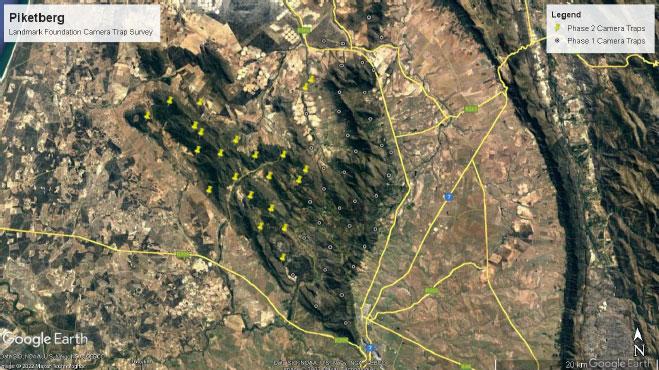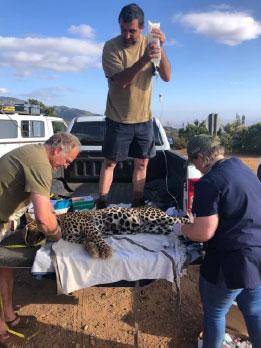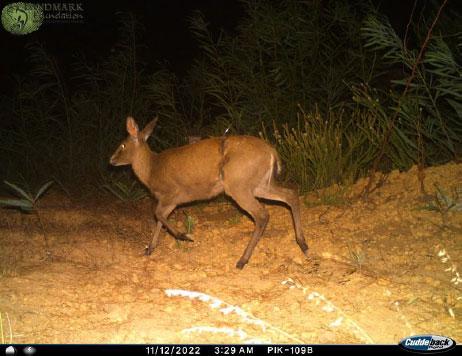Banghoek Wildlife Viewing Report
Written by the Landmark Foundation 9 December 2022

Highlights
• The Landmark Foundation team visited the Piketberg in early October to place an additional 7 stations to the second camera trap survey. As a result, we have 22 active camera trap stations. Between 23rd – 28 November we downloaded the data from the stations. Once we processed the data and removed empty pictures (e.g., false triggers/ wind blowing plants), we captured 3814 photographs. Of these, 57 were of leopards captured across 12 stations. In total, 31 wildlife species were observed.
• We are aware of one incidence where livestock was lost due to leopard in the Piketberg during October and thanks to the collaborating farmer, efforts were made to mitigate the conflict and there was only one livestock lost.
• We are also delighted to report on a successful leopard tagging event that transpired on 30 October. The animal was captured in an area where high volumes of livestock losses were reported. With the collaboration and willingness of the farmer, we released the leopard on the same site it was captured, to monitor its movements and determine if it was responsible for the damage to livestock. We are assisting the farmer in reducing livestock losses and are assisted in this effort by Cape Nature.
• Unfortunately, there have been several deaths of leopards in the broader area (not all within Piketberg itself) during 2022, with the latest reported mortality being a male that was killed in the Clan William area in October in relation to a human-wildlife conflict issue, another male in the Paarl mountains was killed during August, because of snaring and the illegal killing of the leopard. This followed the death of the young adult male found dead on the 20th May in the Piketberg as a result of intraspecific competition (natural causes) – as the animal appeared to have died in a territorial battle with another male leopard (See Report 03 for more details).
Background
The camera trap survey forms part of Landmark Foundations ongoing research effort with the aim of estimating leopard density and uncovering the population dynamics, potential prey availability, and assessing and mitigating human-leopard conflict in the Piketberg. The Piketberg is of important conservation value, offering remnant natural habitat for wildlife in the area. The mountain is surrounded by a highly transformed landscape, thereby acting as an island. There are some natural habitat corridors on the north of the Piketberg mountain connecting toward the Cederberg Mountains, but these areas are narrow and are only present on the north of the mountain, limiting connectivity.
Results
Camera trap survey
The leopard camera trap survey includes 22 camera trap stations (Figure 1) and has extended over 1849 camera trap days (number of camera traps x 24hrs each camera is active). Each camera trap station consists of two camera traps, to capture both flanks of the passing leopard. This assists us with identification of leopards based on their unique fur patterns. We photographed 25 mammal- and 6 bird- (Cape spurfowl, Cape turtle dove, guineafowl, grey-winged francolin, Southern black korhaan and spur-winged goose) and one reptile -species (Table 1). In comparison with the previous survey of the Eastern side of the Piketberg (2019 – 2021), we captured a male vervet monkey. There was a relatively high human presence across the mountain, with 1504 (25%) images of the total 3814 images captured, being associated with human activity (Table 2).

Figure 1. Location of camera trap stations forming part of the leopard research project. The yellow pins depict active camera stations, and the white dots indicate where cameras were previously placed as part of the first phase of the camera trap survey.


Leopard identification
Leopards were photographed on 57 occasions, making up 1.5% of all images, and were observed at a capture rate of 32 camera trap days per leopard picture. Leopards were captured across 12 of the 22 stations. More importantly, from the 57 leopard observations during this phase, we identified 8 leopards: five adult males, two females and one unsexed individual. Of these three males were individuals identified as part of the first survey, while the other two are new additions to the survey.
Human-leopard conflict mitigation
On the 30th October we captured a healthy adult male leopard. We had set a cage in the area nearly 3 months prior, in response to high levels of livestock losses being reported in the area. As part of the Landmark Foundation human-wildlife mitigation effort and larger research effort, we provide tracking collars that provide insights to the leopard’s behaviour that can be used to minimise conflict and promote co-existence. At the same time, we obtain valuable data that contributes to the leopard conservation management to improve conservation efforts. We used drop-off collars, meaning we wouldn’t need to capture the animal again to remove the device. The animal was fitted with a satellite collar and was released on site, thanks the collaborative farmer who was willing to mitigate livestock losses, rather than remove the leopard.
The male is in excellent health, weighing in at 45kg at time of capture, and he is estimated to be approximately 8 years – placing him in his prime. We have monitored his movements and the leopard is occupying as much as 24000ha.
The full story of the leopard capture and rerelease can be found at: https://www.facebook.com/page/133657930001821/search/?q=Leopard%2070&_rdc=1&_rdr

Figure 2. Male leopard captured on 30 October 2022, fitted with collar, and released on site.
As part of our efforts to reduce human-leopard conflict the Landmark Foundation promotes non-lethal predator deterrents such as lights, kraals and other tools that are effective at protecting livestock. In addition, we offer a financial compensation for farmers who are willing to collaborate whereby the aim is to ensure livestock is effectively protected to reduce potentially livestock losses and collar the resident leopard with a satellite collar. This allows us to determine if the individual is causing livestock losses and if further management (e.g., translocation) may be required, or if it was a sporadic, opportunistic attack on vulnerable livestock. These data allow us to find solutions with willing livestock farmers to mitigate losses and conserve leopards. Finding ways to promote tolerance and co-existence between wildlife and productive landscapes is a benefit to everyone.
Please feel free to contact us if you have any conflict with carnivores (details below). We will do our best to try to mitigate such conflict in a partnership with the farmer and with Cape Nature.
Highlights
We highlight some the wildlife activity from cameras over the last few months. These are available for download from https://www.dropbox.com/t/QKkaVvJQDyP2FwB6. The images will be available for download until 16 December. If you missed this download period, not to worry, just send us an email and we’ll have the images available again.
PLEASE NOTE: Snaring appears to be a continuous issue across the Piketberg, and we report on another duiker with snare around its abdomen during the survey. We found a similar image during the visit in August (See Report 03). Reducing snaring activities will go a long way toward conservation in the area. Please be vigilant when walking, remove snares, and communicate to communities and groups the damage and dangers of snaring. If a leopard was to get caught, it would not only be dangerous to a captured leopard, but the person checking the snares as well.

Fundraising initiative
Often people ask us how they can contribute to our work. We are currently running a fundraiser to garner support for our leopard conservation efforts. We are being called out to assist with leopards in peril across the Eastern, Western and Northern Cape to reduce human-leopard conflict, which without these efforts often results in the persecution of the species. It is astonishing that there is still so much persecution of the species when it is demonstrated scientifically that their numbers are dwindling, and their genetics are constrained.
Through the years we have rescued 70 leopards from demise. We have published a lot of science on the species in peered-reviewed journals to promote evidence-based best management. Being operational since 2004, we run arguably the largest and longest running conservation research project in aid of leopard conservation in the world. We believe this cause makes a positive contribution to carnivore conservation and promoting biodiversity outside of protected areas where human-wildlife conflict is high.
Thank you
We wish to thank all the farmers and landowners throughout the Piketberg, as we were warmly welcomed and facilitated by everyone. There is generally a very positive sentiment about the leopards in the area and it is clearly a very important area for wildlife and leopards. The leopard project relies on community by-in, and we are willing to work with everyone who wishes to participate. We sincerely thank Donnie Malherbe and Jaco van Deventer at Cape Nature for sharing information and facilitating us with our work in the area. The partnerships between the Landmark Foundation, Cape Nature and all the landowners allows us to develop a clearer understanding of leopard population dynamics. This contributes to better management actions and species conservation efforts. A sincere thanks to Riette and Kruistementvlei Farm for assisting us with accommodation. We also wish to thank Robin Stubbs, a nature conservation student, who assisted us greatly with field the work as a volunteer during our latest visit.
If you would like any further information, please don’t hesitate to contact us.